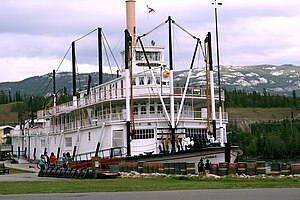
Yukon is the smallest and westernmost of Canada's three territories. It is the third-least populated province or territory in Canada, with a population of 45,148 as of 2023. However, Whitehorse, the territorial capital, is the largest settlement in any of the three territories.
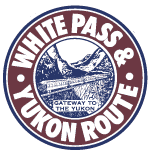
The White Pass and Yukon Route is a Canadian and U.S. Class III 3 ft narrow-gauge railroad linking the port of Skagway, Alaska, with Whitehorse, the capital of Yukon. An isolated system, it has no direct connection to any other railroad. Equipment, freight and passengers are ferried by ship through the Port of Skagway, and via road through a few of the stops along its route.

Dawson City, officially the City of Dawson, is a city in the Canadian territory of Yukon. It is inseparably linked to the Klondike Gold Rush (1896–1899). Its population was 1,577 as of the 2021 census, making it the second-largest city in Yukon.

Klondike Gold Rush National Historical Park is a national historical park operated by the National Park Service that seeks to commemorate the Klondike Gold Rush of the late 1890s. Though the gold fields that were the ultimate goal of the stampeders lay in the Yukon Territory, the park comprises staging areas for the trek there and the routes leading in its direction. There are four units, including three in Municipality of Skagway Borough, Alaska and a fourth in the Pioneer Square National Historic District in Seattle, Washington.

Lake Laberge is a widening of the Yukon River north of Whitehorse, Yukon in Canada. It is fifty kilometres long and ranges from two to five kilometres wide, with an average depth of 54 metres. Its water is always very cold, and its weather often harsh and suddenly variable.
Pelly Crossing is a community in Yukon, Canada. It lies where the Klondike Highway crosses the Pelly River.
Marsh Lake is a widening of the Yukon River southeast of Whitehorse, Yukon, Canada. It is over 30 kilometres long and ranges from three to four kilometres wide. The co-ordinates of the lake are 60°26′10″N134°15′02″W, and is 2,147 feet above sea level. The lake forms part of a chain of finger lakes, sometimes referred to as "The Southern Lakes", that form the headwaters of the Yukon River.
Canyon City is a Klondike Gold Rush ghost town and a Yukon Government Heritage Site. It is located about 7 km from downtown Whitehorse, Yukon at the upstream end of Miles Canyon on the Yukon River. Summer tours are encouraged.

CKRW-FM is a hot adult contemporary radio station in Whitehorse, Yukon, Canada.

The Moyie is a paddle steamer sternwheeler that worked on Kootenay Lake in British Columbia, Canada from 1898 until 1957.
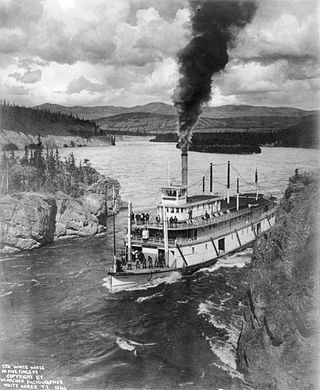
Steamboats on the Yukon River played a role in the development of Alaska and Yukon. Access to the interior of Alaska and Yukon was hindered by large mountains and distance, but the wide Yukon River provided a feasible route. The first steamers on the lower Yukon River were work boats for the Collins Overland Telegraph in 1866 or 1867, with a small steamer called Wilder. The mouth of the Yukon River is far to the west at St. Michael and a journey from Seattle or San Francisco covered some 4,000 miles (6,400 km).
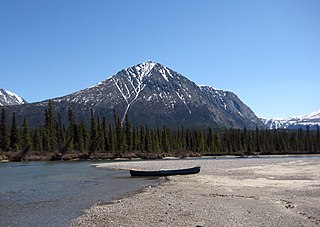
The Takhini River is a watercourse in Yukon, Canada. The river is located just north of Whitehorse, Yukon, and flows from west to east, meeting the Yukon River at a point between Whitehorse and Lake Laberge. During the winter, the river freezes and serves as part of the route of the Yukon Quest sled dog race.

Braeburn Lodge is a roadhouse on the Klondike Highway in the Yukon Territory of Canada. It is located east of Braeburn Lake and north of Braeburn Mountain, on the path of the former Dawson Overland Trail, which was built in 1902 between Whitehorse and Dawson City. The lodge itself is a tourist destination and is famous for its large cinnamon buns. Nearby Cinnamon Bun Airport is named for the lodge's cinnamon buns. Every February, Braeburn Lodge hosts a checkpoint of the long-distance Yukon Quest sled dog race.

The Stewart River is a 533-kilometre (331 mi) tributary of Yukon River in the Yukon Territory of Canada. It originates in the Selwyn Mountains, which stand on the border between the Northwest Territories and the Yukon Territory. From there, the Stewart flows west, past the village of Mayo. The river is crossed by the Klondike Highway at the village of Stewart Crossing, and the highway parallels the river westward for about 56 kilometres (35 mi). After leaving the highway, the river travels southwest until it intersects the Yukon River 112 kilometres (70 mi) south of Dawson City. The mostly abandoned village of Stewart River is located at the mouth of the river.
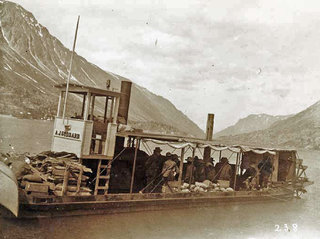
A. J. Goddard was a Klondike Gold Rush era sternwheeler owned by Seattle businessman Albert J. Goddard and built for transport of men and supplies on the Upper Yukon River in Canada. She was assembled from pieces which were manufactured in San Francisco, shipped up to Skagway, Alaska, hauled over the Coast Mountains, and finally assembled at Lake Bennett. She made one trip to Dawson during the gold rush, was sold and sank in a storm on Lake Laberge in 1901. Her wreck was discovered in 2008 by Doug Davidge and was designated as a Yukon Historic Site.

Downtown Whitehorse is a neighbourhood in Whitehorse, Yukon. The downtown area serves as Whitehorse's city centre and central business district.

In what was characterized as the worst disaster in the Yukon River's history, the sternwheeler Columbian exploded and burned at Eagle Rock, Yukon, Canada, on 25 September, 1906, killing six men. The steamer was carrying a crew of twenty-five men and a full cargo, including cattle and three tons (2.722 t) of blasting powder destined for the Tantalus coal mine, thirty miles (48 km) downriver.

The SS Keno is a preserved historic sternwheel paddle steamer, a National Historic Site of Canada, and a unit of the Canadian national park system. The SS Keno is berthed in a dry dock on the waterfront of the Yukon River in Dawson City, Yukon, Canada.

Alaska Transportation Company was founded on April 5, 1898, in Seattle, Washington by Andrew F. Burleigh (1846-1907) and George W. Dickinson. Alaska Transportation Company was formed to cash in on the gold rush happening around Dawson City and Nome in Canada, known as the Klondike Gold Rush. Klondike Gold Rush peaked between 1896 and 1899 in Klondike, Yukon. Alaska Transportation Company sold shares in the company to raise funds to build a ship to travel up the Yukon River. The ship would depart from Puget Sound ports. Moran Brothers Company of Seattle got the contract to build the nine steamships to be used. Alaska Transportation Company headquarters was at Pier 58 in Seattle. Both Andrew F. Burleigh and George W. Dickinson had previously worked for the Northern Pacific Railway as attorneys. Andrew F. Burleigh had a short law partnership with James B. Metcalfe and Charles W. Turner. Captain James Griffiths worked at Alaska Transportation Company before starting his own firm James Griffiths & Sons, Inc. In 1896 Andrew F. Burleigh founded the Yukon Company to operate ships and barges on the Yukon River. Alaska Transportation Company did not purchase surplus World War II ships, with an aged fleet of ships and competition from the Alaska Highway opened in 1942, the company closed in 1948.
